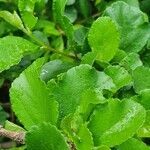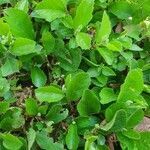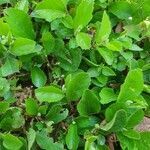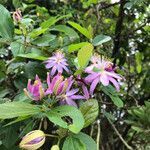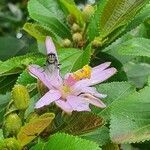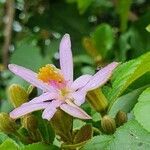Shrub or small tree, sometimes scandent, up to 4.5(–7.5) m tall; young stems stellate-pubescent, sometimes densely so or with long hairs.. Leaves ovate to elliptic or obovate, 0.6–10.5 cm long, 0.5–6.7 cm wide, obtuse to rounded at the apex, rounded at the base, margins serrate, ± glabrous above, scattered stellate-pubescent to glabrescent beneath; petiole 2–8 mm long, shortly stellate-pubescent or with long hairs; stipules subulate, 2–5 mm long.. Inflorescences terminal and axillary 2–6-flowered cymes; peduncle 3–18 mm long, pubescent with stellate and simple hairs; pedicels 8–18 mm long, pubescent with stellate and simple hairs.. Flowers purple, blue, mauve or pink; sepals lanceolate, 11–25 mm long, green and pubescent on the outside; petals elliptic to elliptic-oblong, 8–15 mm long, 2.5–5 mm wide, obtuse or notched at the apex.. Androgynophore glabrous for ± 0.5–1 mm at the base, densely pubescent and produced for 2–5.5 mm above the node.. Stamens 7–10 mm long; filaments purple; anthers yellow.. Ovary 1.5–2 mm long, densely hairy; style 5–9 mm long; stigma green.. Fruit (1–)4-lobed, 8–15 mm wide, the lobes 5–8 mm long, 4–7 mm wide, green maturing orange to orange-red, sometimes yellow or red, sparsely hairy.. Fig. 3/1 (leaf, p. 9).
More
A shrub or small tree. It grows 3 m high. It can be a climber growing 9 m high. The bark is smooth and grey brown. It becomes rougher with age. The leaves are broadly oval and 5 cm long. They are glossy green above. The tip can be rounded or notched. There are teeth along the edge. There are 3 veins from the base. The young shoot are hairy. The flowers are red or pink. The anthers are yellow. The flowers are 2 cm across. There are 3-6 flowers in a group at the ends of branches or in the axils of leaves. The fruit are fleshy berries. They are green but turn orange then red as they ripen. The fruit have 4 lobes and each lobe is about 5 mm across. The ripe fruit is edible.
